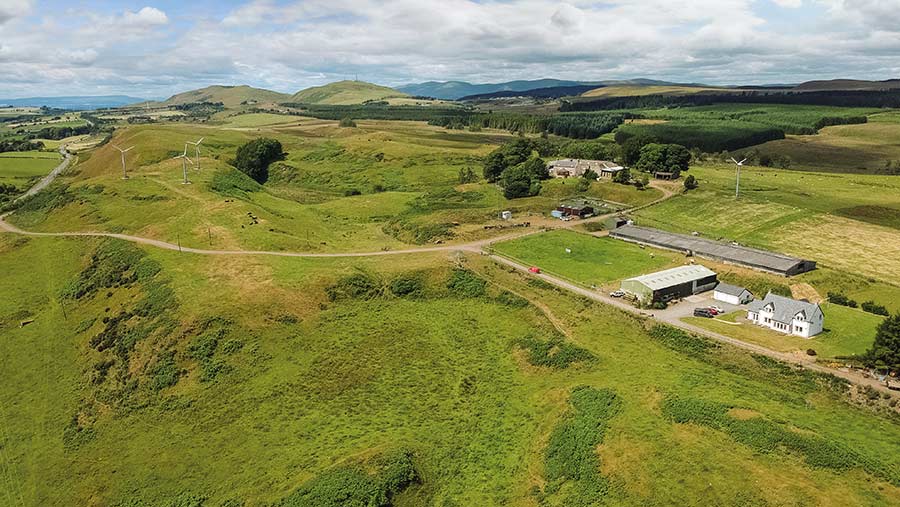Strong Scottish market sees more land sold in 2022
 Roscobie Farm, Dunfermline, was on the market for offers of more than £1.6m and sold last month © Strutt & Parker
Roscobie Farm, Dunfermline, was on the market for offers of more than £1.6m and sold last month © Strutt & Parker Supply of land for sale in Scotland recovered in 2022 from its 2021 pandemic low, with a 48% rise in the area on the open market.
It was the busiest summer in acreage terms for 10 years, according to Strutt & Parker’s Scottish Farmland Review, which estimates that one in five farms was for sale off-market.
The number of holdings openly for sale, at 87, was in line with the five-year average, which in turn had been pulled down by just 77 holdings being openly marketed in 2021.
See also: Succession questions? Watch Farmers Weekly’s Business Clinic webinar
Demand remained higher than supply, farms on the whole sold well, and record-breaking prices were paid for arable land on the east coast and for land with commercial forestry or carbon project potential, Strutt & Parker said.
More hill farms offered
There was a notable rise in the number of hill farms on the market, accounting for 27% of holdings offered in 2022, rather than their more usual share of 10-20%.
“This signals that some farmers have been tempted to take advantage of the premium prices that have been on offer from forestry and natural capital buyers,” said Diane Fleming, farm agent for the firm in Scotland.
Prices for tree planting land peaked in the first half of the year, reaching more than £8,000/acre in some instances, but cooled in the second half of the year.
The firm suggested this may have been because of a change in the rules on how carbon credits can be attributed to commercial plantations, coupled with a rise in supply and because some buyers had spent their budgets by that point.
“Our data shows that values for land suitable for afforestation fell back to £5,000-£5,500/acre in the third and fourth quarters,” Ms Fleming said.
“This was clearly a significant change and shows how dynamic the market currently is, although upland prices remain well above traditional agricultural values.”
Prices for other land types were much more stable, with demand robust across all farm types.
“Farms on the whole sold well, and with a record-breaking price well in excess of £20,000/acre paid for some arable land on the east coast,” said Ms Fleming.
“The average value of prime arable land on the east coast was £9,500/acre, much in line with 2021, but varied widely according to location, from an average of £4,500/acre in the Highlands to £16,000/acre in the Lothians.”
The average price paid for grass leys rose to £4,000/acre from £3,500/acre in 2021.
Scottish land market 2022 – key points
- 41,600 acres publicly advertised, up 48% on 2021 levels and 30% above five-year average
- Values rose across all land types in the first half of the year, flattening during autumn and winter
- 89% of farms publicly marketed had found a buyer by the end of the year
- 87 farms marketed, 27% upland hill farms
- Main buyers were farmers, with increased demand from non-farming investors especially for forestry and Environmental, Social and Governance reasons
- A quarter of farms marketed, which is more than average, were larger than 500 acres, and 12 of these exceeded 1,000 acres
- Of the farms marketed in the first half of 2022, the turn of the year saw 89% having completed, concluded missives (reached agreement on a binding contract) or under offer
- Demand is strong across all farm types but larger hill farms asking £3m or more are taking longer to sell than other types
- Bids above the asking price were achieved in 75% of sales for which Strutt & Parker has data, which is lower than the 89% reported for 2021
Reasons for selling
The main driver for sales in 2022 was retirement, sometimes earlier than planned as vendors perceived it to be the right time as the farmland market was performing well and with so much uncertainty in farming and the wider economy.
Some non-farming vendors sold for similar economic reasons, taking their money out of the land in order to help family members or bolster other business interests.
Outlook
Despite the huge uncertainty over farm policy and global economics, the Scottish farmland market is expected to remain strong this year, with the level of demand sufficient to cope with an expected stronger supply.
Cash will be king, with non-farming investors making up a larger proportion of buyers, says Strutt & Parker.
